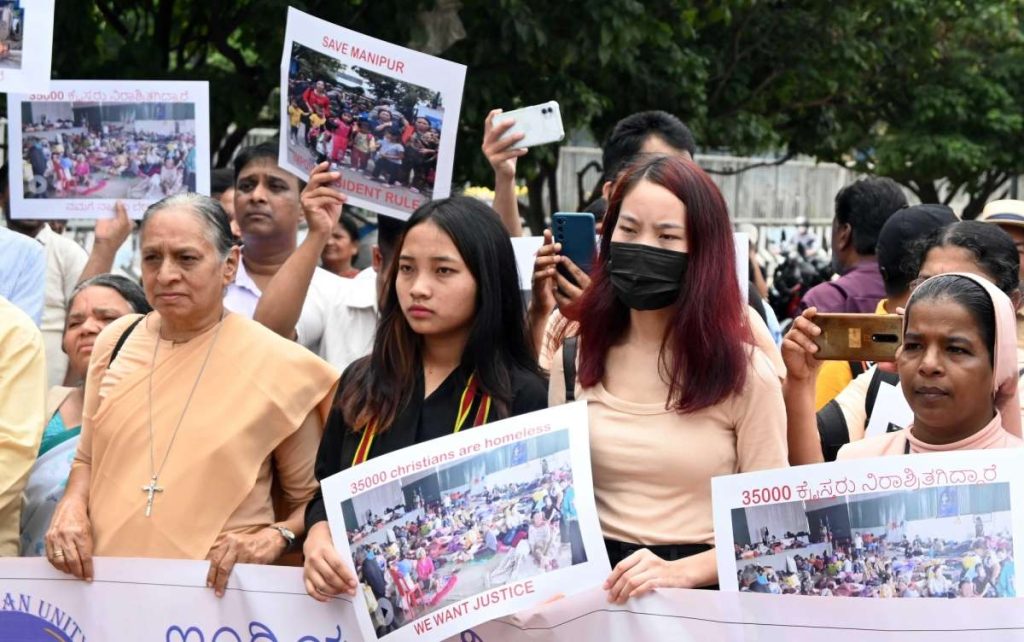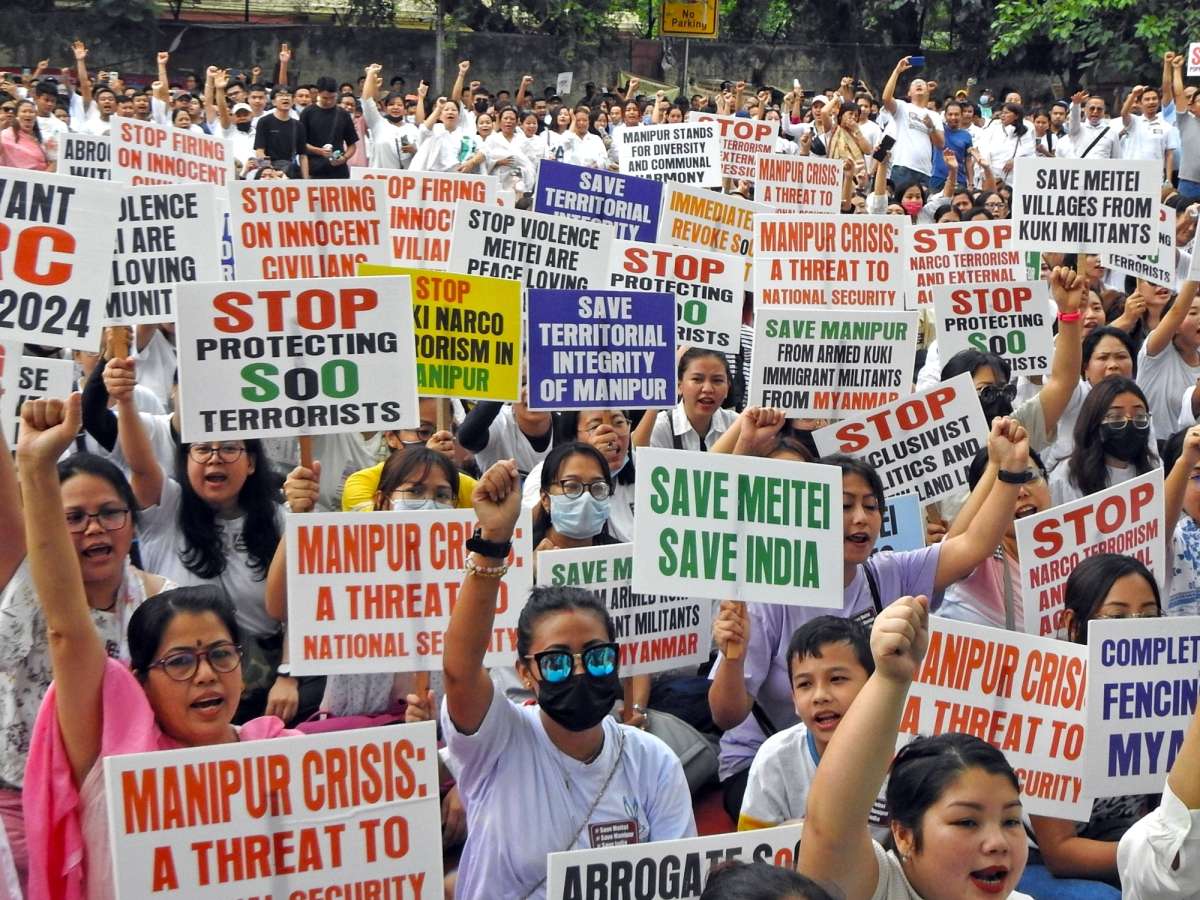Contrary to a prevailing religious narrative, the root cause of these conflicts lies in ethnic divisions. To achieve lasting peace and harmony, it is crucial to acknowledge that this clash stems from ethnic identity, not religious differences. Over thirty tribal communities inhabiting Manipur, each with its distinct cultural identity and aspirations. Open dialogue, empathetic understanding, and inclusive policies that respect the rights and aspirations of all communities are essential to addressing these concerns … writes Dr Sarath Verma
The state of Manipur finds itself engulfed in a series of ethnic clashes, fuelled by a complex mix of historical grievances, land disputes, and political aspirations. These factors have contributed to growing animosity among the diverse communities residing in this region.
Contrary to a prevailing religious narrative, the root cause of these conflicts lies in ethnic divisions. With over thirty tribal communities inhabiting Manipur, each with its distinct cultural identity and aspirations, clashes and tensions have become a recurrent feature, creating a highly volatile environment.

To comprehend the origins of these clashes, one must delve into Manipur’s rich history, where migration, invasions, and the passage of time have intricately woven the threads of its destiny. When the British arrived in Manipur, they introduced administrative reforms and redefined boundaries. Little did they anticipate that their actions would inadvertently sow the seeds of division among the diverse people of Manipur. It is possible that this was a deliberate strategy, aligned with their “Divide and Rule” policy.
With the advent of India’s independence, a new chapter unfolded in Manipur’s history. Ethnic tensions simmered as different communities emerged from the shadows, eager to protect their interests and assert their unique identities. The demand for separate administrative units or autonomous regions became a rallying cry, symbolizing both pride and contention.
As aspirations clashed and grievances festered, Manipur transformed from a once harmonious land into a crossroads of conflict. Communities that had coexisted for generations suddenly found themselves pitted against one another, each vying for a share of the metaphorical pie.
Among the intricate ethnic landscape of Manipur, the Meitei-Naga conflict stands as a deeply entrenched fault line. The Meiteis, primarily residing in the valley region, have long grappled with a sense of marginalization and perceived threats from the dominant Naga community in the hills. This has fueled violent clashes and persistent insurgencies, leaving scars of loss and displacing communities caught in the crossfire.
Another significant flashpoint is the Kuki community, an indigenous group inhabiting both the hills and the valley. The Kukis have valiantly fought for recognition and autonomy, often finding themselves at odds with the Naga community over contentious land disputes. This protracted struggle has given rise to cycles of violence, forced displacements, and deep-rooted animosity that continue to resonate in Manipur’s collective memory.
Amidst these complexities, the Pangals, a minority in Manipur, have experienced marginalization and discrimination. Cultural differences and historical grievances have ignited tensions between the Pangals and other communities, resulting in sporadic clashes that further complicate the delicate social fabric.

The consequences of these ethnic clashes have cast a long, somber shadow over Manipur and its people. Lives have been tragically lost, families uprooted, and a pervasive fear and mistrust have permeated the region. Resolving these conflicts and forging a path towards lasting peace requires a deep understanding of their intricate roots and a resolute commitment to fostering understanding and harmony among warring factions.
Recognising the urgency, the Government of India has taken steps to address the ethnic conflicts in Manipur. Security forces have been deployed, and measures such as the implementation of the Armed Forces Special Powers Act (AFSPA) have been put into effect. Initiatives for dialogue with various groups have been launched, while civil society organizations, local leaders, and peace activists have played crucial roles in bridging gaps and nurturing understanding among conflicting communities.
However, despite earnest efforts to address these ethnic conflicts, recent events have once again brought them into the spotlight, reigniting tensions that continue to smolder. The clash between the Meitei people and tribal communities, including the Kukis, has become a focal point of renewed conflict. At the heart of this dispute lies the Meiteis’ demand for Scheduled Tribe (ST) status under the Indian Constitution, which would grant them certain privileges akin to those enjoyed by tribal communities.
Although driven by a desire for recognition and equal treatment, this demand has faced vehement opposition from tribal communities who fear that granting ST status to the Meiteis would result in encroachments upon hilly regions and the usurpation of their ancestral lands. The situation rapidly escalated when the All Tribal Student Union of Manipur (ATSUM) organized a solidarity march, inadvertently triggering clashes between the Meitei and Kuki populations in the Churachandpur district.
To restore law and order and suppress escalating violence, the Indian Army and paramilitary forces were deployed, imposing curfews and suspending internet services. Recognizing the gravity of the situation, the government established investigative panels and peace committees to delve into the root causes of these clashes, aiming to uncover underlying factors through impartial investigations.
Earlier this year, the Manipur state government took action to remove illegal immigrants from settlements in reserve forest areas. While officials claimed an influx of illegal immigrants from Myanmar had occurred since the 1970s, tribal groups expressed concerns that these efforts were a smokescreen to drive the tribal population from their lands. Eviction drives in districts like Churachandpur, Kangpokpi, and Tengnoupal were seen as anti-tribal, further fueling tensions.
In another development, the Manipur Cabinet decided to withdraw from Suspension of Operation agreements with three Kuki militant groups in March. However, the central government did not support this decision, leading to demonstrations in New Delhi by Manipuri organizations demanding the creation of a National Register of Citizens (NRC) with 1951 as the base year. They voiced concerns about abnormal population growth in the hill areas, further exacerbating ongoing tensions.
Against the backdrop of mounting tensions, the initial sparks of violence were ignited as clashes erupted in the Kangpokpi district. Protesters had gathered to rally against the encroachment of tribal lands under the guise of reserved forests, protected forests, and wildlife sanctuaries.
Tensions escalated further when a judge of the Manipur High Court instructed the state government to consider the Meitei community’s request for inclusion in the Scheduled Tribes (ST) list on April 20. This decision fueled fears among the Kukis that granting ST status to the Meiteis would enable them to purchase land in the prohibited hilly areas.
In response, various tribal groups called for a total shutdown as a protest on April 28, coinciding with Chief Minister N. Biren Singh’s planned visit to Churachandpur for the inauguration of an open-air gym. Prior to the visit, an angry mob set fire to the gym, resulting in chaos and disorder. To maintain control, Section 144 was invoked to restrict public gatherings, and a five-day internet shutdown was imposed. Protesters clashed with the police, while tear gas shells were deployed to disperse the crowds.
These incidents serve as stark reminders of the deep-rooted tensions and conflicts gripping Manipur. Issues of illegal immigration, encroachment on tribal lands, and demands for inclusion in the ST list have further inflamed ethnic divisions. To achieve lasting peace and harmony, it is crucial to acknowledge that this clash stems from ethnic identity, not religious differences. Open dialogue, empathetic understanding, and inclusive policies that respect the rights and aspirations of all communities are essential to addressing these concerns.

